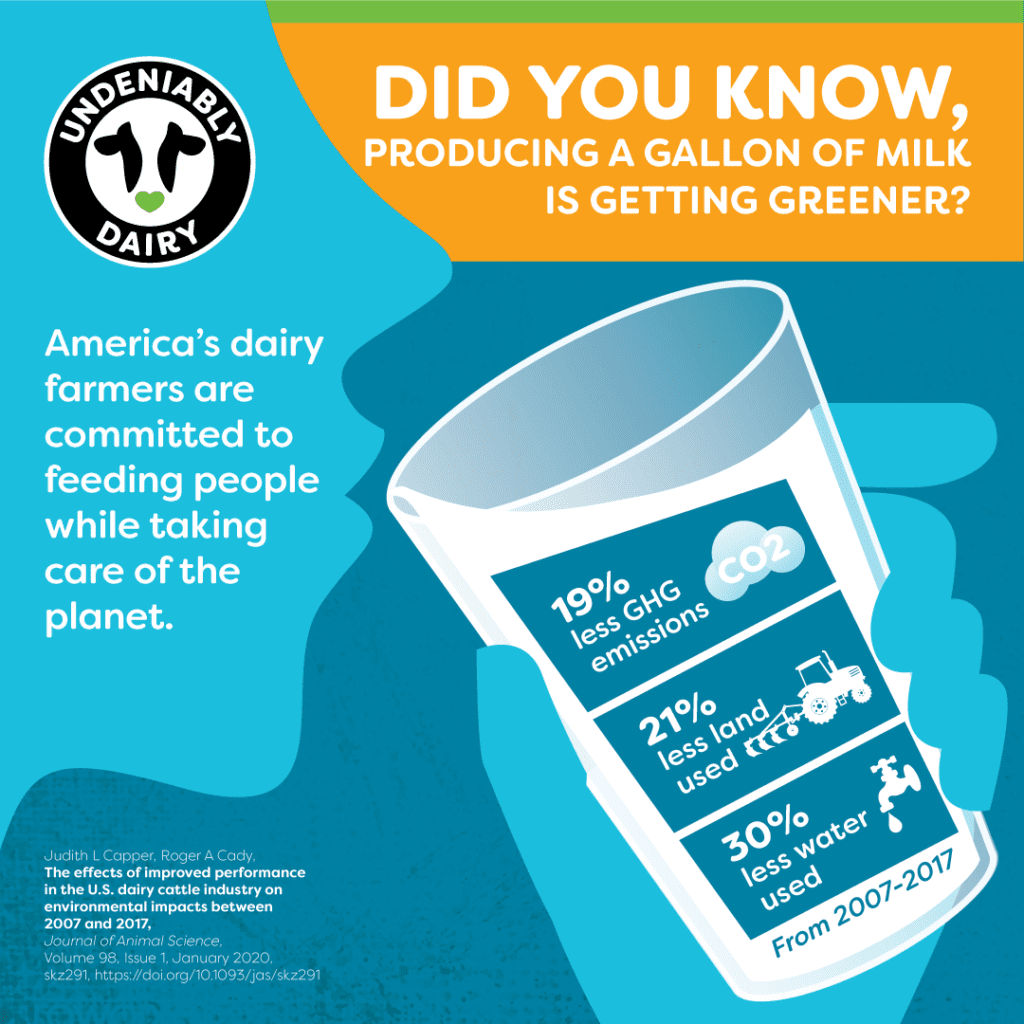Share this page
Dairy is working together to be an environmental solution
U.S dairy has set new 2050 environmental goals to be carbon neutral or better, optimize water use, while maximizing recycling and improve water quality by optimizing utilization of manure and nutrients.



Alignment with SDGs
AUTHOR
Dr Jamie Jonker US - IDF • United States of America
Abstract
U.S. Dairy’s 2050 environmental goals build on a decades-long commitment to producing nutritious dairy foods that can sustainably feed a growing population. In 2009, the U.S. Department of Agriculture and the Innovation Center for U.S. Dairy agreed to work jointly in support of the industry’s first voluntary goal, to reduce GHG emissions for fluid milk by 25 percent by 2020. Years of research, investment in new technologies and improved on-farm practices have resulted in significant progress. Producing a gallon of milk in 2017 involved 30 percent less water, 21 percent less land and a 19 percent smaller carbon footprint than it did in 2007, according to a study published in the Journal of Animal Science. Earlier this year, U.S. dairy set new, voluntary environmental goals to align with SDGs 6, 12, and 13 and advance its ability to build a sustainable future. The goals include achieving neutral carbon emissions (or better), optimized water usage and improved water quality by 2050.
The SDGs call for transformative change around the world to improve lives and foster environmental stewardship. U.S. dairy aspires to be an environmental solution and is contributing to this call to action by setting new environmental goals to be carbon neutral or better, optimize water use and improve water quality by 2050.
Moving the wheel
Through the Innovation Center for U.S. Dairy, farmers, cooperatives, processors and other stakeholders established the U.S. Dairy Stewardship Commitment. Stewardship Commitment reporting correlates with global dairy sustainability indicators and is recognized as meeting global reporting standards to demonstrate how U.S. dairy supports the SDGs.
As an aide to the Stewardship Commitment, the 2019 Materiality Assessment and Guide align along two dimensions: (1) significance of social, environmental and economic impacts and (2) importance to stakeholders. This provided a strong foundation for setting 2050 environmental goals for U.S. dairy. The Innovation Center’s Environmental Stewardship Committee, through a year-long consultation process and with input from the multi-stakeholder Dairy Sustainability AllianceÆ, developed the new goals, approved by the Innovation Center Board of Directors, that that articulate the collective U.S. dairy intention and direction to pursue dairy as an environmental solution.
History of success
In 2008, the Innovation Center embarked upon a science-based approach to measure and improve the industry’s environmental footprint. According to a comprehensive life cycle assessment (LCA) commissioned by the industry, the production of all dairy products in the U.S. accounts for around 2 percent of total U.S. GHG emissions.
U.S. dairy used the research as the foundation for the creation of best practices and tools for producers, processors, and others throughout the dairy supply chain to make meaningful change in the field, on farm and in plant. The LCA also helped identify opportunities to further reduce GHG emissions while providing an important baseline for U.S. dairy.
Developing new 2050 environmental goals to help meet the SDGs demonstrates U.S. dairy’s long-standing values of responsible production, nourishing communities, and continuous improvement.
Dr Jamie Jonker Tweet
The value of the initiative
Collaboration is at the heart of the U.S. dairy community. Through International Dairy Federation, Dairy Sustainability Framework, Food and Agriculture Organization of the United Nations and other global dairy networks, the U.S. dairy community is working to understand and tackle complex issues around sustainable food systems, taking an integrated approach to continuously improve the sustainability of dairy systems and contribute to the achievement of key SDGs such as protecting the environment and ending hunger.
Developing new 2050 environmental goals to help meet the SDGs demonstrates U.S. dairy’s long-standing values of responsible production, nourishing communities, and continuous improvement. The people that depend on nutritious dairy foods to support their health and well-being share these values.



New opportunities
U.S. Dairy will work collaboratively to accelerate progress toward the new environmental goals and increase access to affordable technologies and practices. Foundational work on environmental and economic research will inform decisions, update models and advance outcomes for dairy farmers. Expedited economic and environmental projects will create new revenue streams as a catalyst for solutions. And collaborative action will stimulate greater access to technical, financial, and educational support and motivate adoption of environmental practices across all dairy farms. To ensure continued momentum, progress toward these targets will be measured and reported in aggregate every 5 years, starting in 2025, through 2050 using meaningful markers of progress such as those found in the U.S. Dairy Stewardship Commitment.






